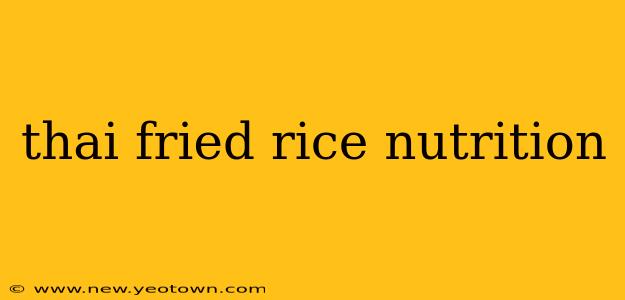Thai fried rice is a beloved dish across the globe, known for its vibrant flavors and satisfying texture. But how healthy is it, really? Let's delve into the nutritional aspects of this popular cuisine, exploring its potential benefits and drawbacks. This isn't just about calories; we'll explore the macro and micronutrients, uncovering the nutritional secrets within each delicious bite.
What are the main ingredients in Thai fried rice?
The beauty of Thai fried rice lies in its versatility. While recipes vary, the core ingredients typically include rice (often jasmine rice), eggs, vegetables (like peas, carrots, onions, and sometimes broccoli or peppers), and protein (usually chicken, shrimp, pork, or tofu). The magic happens with the addition of flavorful sauces – fish sauce, soy sauce, oyster sauce, and often a touch of sugar and chili garlic sauce. This combination gives it that distinctive, savory-sweet-spicy kick. The specific nutritional profile will vary dramatically based on the protein source and the amount of oil used in the cooking process.
How many calories are in a serving of Thai fried rice?
This is a tricky question! A single serving of Thai fried rice can range anywhere from 300 to 700 calories, depending on portion size, ingredients, and preparation method. A restaurant serving is likely to be on the higher end of that scale, often exceeding 600 calories. Home-cooked versions, with lean protein and less oil, can be significantly lower. The type of rice used also makes a difference, with brown rice being a healthier option than white rice due to its higher fiber content.
Is Thai fried rice a healthy option?
The healthiness of Thai fried rice truly depends on the ingredients and preparation. It can be a healthy and balanced meal if made with plenty of vegetables, lean protein, and minimal added oil and sugar. The abundance of vegetables contributes vitamins, minerals, and fiber. Lean protein sources, like chicken breast or tofu, provide essential amino acids. However, the reliance on soy sauce and fish sauce can contribute to high sodium content, a concern for people watching their salt intake.
Can I make Thai fried rice healthier?
Absolutely! Here are some tips for creating a healthier version:
- Choose brown rice: Opt for brown rice over white rice for increased fiber and nutrients.
- Load up on veggies: More vegetables mean more vitamins, minerals, and fiber, and less room for higher-calorie ingredients.
- Go lean with protein: Select lean protein sources like chicken breast, shrimp, tofu, or even edamame.
- Reduce the oil: Use a minimal amount of oil for stir-frying, perhaps opting for cooking spray or a healthy oil like avocado oil.
- Control the sodium: Reduce the amount of soy sauce and fish sauce, relying more on fresh herbs and spices for flavor.
- Watch the sugar: Limit the amount of sugar added to the sauce.
What are the nutritional benefits of Thai fried rice?
When prepared healthily, Thai fried rice can offer several nutritional benefits:
- Good source of protein: Provides essential amino acids for muscle building and repair.
- Rich in vitamins and minerals: Contains various vitamins and minerals from the vegetables, depending on what's included.
- Provides fiber: Aids in digestion and can help regulate blood sugar levels (especially with brown rice).
What are the potential downsides of Thai fried rice?
The potential downsides primarily stem from unhealthy preparation methods:
- High in sodium: Soy sauce and fish sauce contribute significantly to sodium content.
- High in calories: Can be calorie-dense, especially when made with lots of oil and high-calorie ingredients.
- May be high in saturated fat: Depending on the oil used and the type of protein included.
Is Thai fried rice good for weight loss?
Thai fried rice can be part of a weight-loss diet, but only if prepared mindfully. Portion control is key. Focusing on a healthy preparation method with plenty of vegetables, lean protein, and minimal oil will drastically impact its caloric value and make it a more suitable addition to a weight-loss plan.
By understanding the nutritional components and adapting the recipe, you can enjoy this flavorful dish while prioritizing your health. Remember, the key is moderation and conscious ingredient choices!

